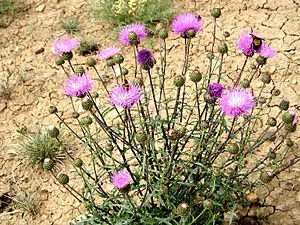Rocky Mountain thistle facts for kids
Quick facts for kids Rocky Mountain thistle |
|
|---|---|
 |
|
| Conservation status | |
| Scientific classification | |
| Genus: |
Cirsium
|
| Species: |
perplexans
|
The Rocky Mountain thistle (Cirsium perplexans) is a special kind of flowering plant. It belongs to the aster family, which also includes sunflowers! People sometimes call it the Adobe Hills thistle. This plant is found only in Colorado, a state in the United States. It grows in the Colorado and Gunnison River Valleys, which are part of the Rocky Mountains.
Contents
What Does It Look Like?
The Rocky Mountain thistle is a plant that lives for two years. It grows from a main root called a taproot. The plant can reach about one meter (or about three feet) tall. Its stems have a thin, web-like covering.
The leaves of this thistle can be up to 30 centimeters (about 12 inches) long and 6 centimeters (about 2.5 inches) wide. Sometimes, the leaves are smooth, but they always have jagged edges. The leaves feel woolly, especially on their undersides.
Flowers and Seeds
The plant has special flower heads. These heads are full of long, lavender or purplish flowers. After the flowers, the plant makes a fruit called an achene. This achene can be more than 2 centimeters (almost an inch) long. It has a fluffy part called a pappus that helps it fly in the wind.
Where Does It Grow?
This thistle lives in western Colorado. It usually grows on open areas with clay-based soils. These areas are often called "adobe hills." You can find it in different types of habitats. These include pinyon-juniper woodlands, areas with sagebrush, and shrublands.
Plant Neighbors
Some of the common plants growing nearby are the pinyon pine (Pinus edulis) and Utah juniper (Juniperus osteosperma). You might also see big sagebrush (Artemisia tridentata) and saltbush (Atriplex confertifolia). Other neighbors include Utah serviceberry (Amelanchier utahensis) and Gambel's oak (Quercus gambelii).
The Rocky Mountain thistle likes to grow in open spots where there aren't too many other plants. It can handle some changes to its home. Sometimes, you might even see it growing along the sides of roads.
Protecting the Rocky Mountain Thistle
The Rocky Mountain thistle faces some challenges. One big problem comes from insects that are released to control other types of thistles. These are called biological pest control agents.
For example, a small beetle called the weevil (Rhinocyllus conicus) was released to stop a different thistle, the musk thistle. But this weevil also started attacking native thistles, like C. perplexans. Another weevil, Larinus planus, has been released near where C. perplexans lives. Scientists are still watching to see if this weevil will also harm the Rocky Mountain thistle.
Other Threats
Another danger is herbicides. These are chemicals used to kill unwanted plants. If herbicides are used to control invasive thistles, they might accidentally hurt the native Rocky Mountain thistle too.
Too much disturbance to its habitat can also be a problem. While the thistle can handle some changes, things like off-road vehicles can cause a lot of damage to its home. Busy roads can also be harmful.
Some new plants that are not native to the area can also be a threat. These include smooth brome (Bromus inermis) and yellow sweet clover (Melilotus officinalis). These new plants can compete with the native thistle for space and resources.
See also
 In Spanish: Cirsium perplexans para niños
In Spanish: Cirsium perplexans para niños


